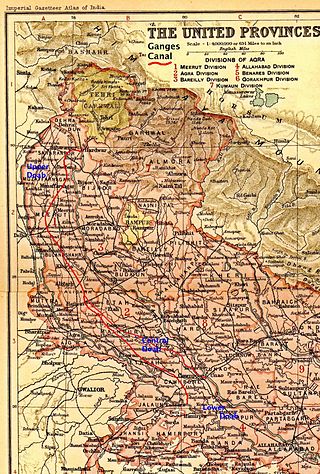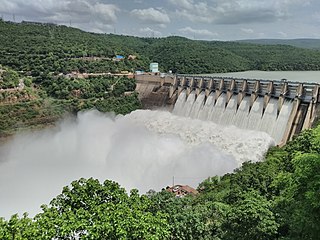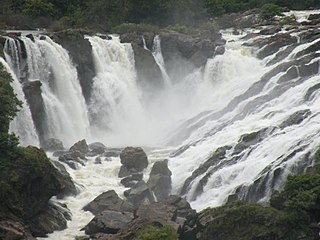
The Ganges is a trans-boundary river of Asia which flows through India and Bangladesh. The 2,525 km (1,569 mi) river rises in the western Himalayas in the Indian state of Uttarakhand. It flows south and east through the Gangetic plain of North India, receiving the right-bank tributary, the Yamuna, which also rises in the western Indian Himalayas, and several left-bank tributaries from Nepal that account for the bulk of its flow. In West Bengal state, India, a feeder canal taking off from its right bank diverts 50% of its flow southwards, artificially connecting it to the Hooghly River. The Ganges continues into Bangladesh, its name changing to the Padma. It is then joined by the Jamuna, the lower stream of the Brahmaputra, and eventually the Meghna, forming the major estuary of the Ganges Delta, and emptying into the Bay of Bengal. The Ganges–Brahmaputra–Meghna system is the second-largest river on earth by discharge.

Small hydro is the development of hydroelectric power on a scale suitable for local community and industry, or to contribute to distributed generation in a regional electricity grid. Exact definitions vary, but a "small hydro" project is less than 50 megawatts (MW), and can be further subdivide by scale into "mini" (<1MW), "micro" (<100 kW), "pico" (<10 kW). In contrast many hydroelectric projects are of enormous size, such as the generating plant at the Three Gorges Dam at 22,500 megawatts or the vast multiple projects of the Tennessee Valley Authority.

Haridwar is a city and municipal corporation in the Haridwar district of Uttarakhand, India. With a population of 228,832 in 2011, it is the second-largest city in the state and the largest in the district.
Newfoundland and Labrador Hydro, commonly known as Hydro, is a provincial Crown corporation that generates and delivers electricity for Newfoundland and Labrador, as well as portions of Quebec and the north-eastern areas of the United States. Between 2007 and 2021, NL Hydro was a subsidiary of the provincial Crown-owned energy holding company Nalcor Energy.

The Ganges Canal or Ganga Canal is a canal system that irrigates the Doab region between the Ganges River and the Yamuna River in India.

Qasimpur Power House Colony is a census town in Aligarh district in the Indian state of Uttar Pradesh. It was established for the employees of Harduaganj Thermal Power Station. It is situated on Aligarh-Moradabad highway at a distance of 16 km from Aligarh and 40 km from Khair.
Sidrapong Hydroelectric Power Station, located at the foothills of Arya Tea Estate 12 km (7.5 mi) from Darjeeling town, is the oldest hydel power station or hydroelectric power plant in India. commissioned on 10 November 1897, its original capacity was 2 × 65 kW, which was expanded in phases for increased demands to a total 1000 kW in 1916. Having reached the limit of the water supply, the machinery was replaced in 1931 for more-efficient triple-phase transmission.

The Srisailam Dam is constructed across the Krishna River in Nandyal district, Andhra Pradesh and Nagarkurnool district, Telangana near Srisailam temple town and is the 2nd largest capacity working hydroelectric station in India.

Run-of-river hydroelectricity (ROR) or run-of-the-river hydroelectricity is a type of hydroelectric generation plant whereby little or no water storage is provided. Run-of-the-river power plants may have no water storage at all or a limited amount of storage, in which case the storage reservoir is referred to as pondage. A plant without pondage is subject to seasonal river flows, so the plant will operate as an intermittent energy source. Conventional hydro uses reservoirs, which regulate water for flood control, dispatchable electrical power, and the provision of fresh water for agriculture.

The ongoing pollution of the Ganges, the largest river in the Indian subcontinent, poses a significant threat to human health and the environment. The river, which is severely polluted with human waste and industrial contaminants, provides water to about 40% of India's population across 11 states, serving an estimated population of 500 million people, more than any other river in the world.

National Capital Power Station (NCPS) or NTPC Dadri, is the power project to meet the power demand of National Capital Region (India). It has a huge coal-fired thermal power plant and a gas-fired plant and has a small township located in Uttar Pradesh, India for its employees. It is located in Gautam Budh Nagar district of Uttar Pradesh about 25 km from Ghaziabad and about 9 km from Dadri. It is nearly 48 km from New Delhi towards Hapur. The township has an area of about 500 acres over all. NTPC Dadri is a branch of National Thermal Power Corporation (NTPC).
Bahadrabad is an intermediate Village Panchayat in the Haridwar district of Uttarakhand, India. It is one of the six development blocks in Haridwar district under which many developed villages come, including Atmalpur Bongla, Rohalki-Kishanpur, Alipur, Garhmeerpur, Khedli, Sitapur.
Harduaganj Thermal Power Station is located at Qasimpur Power House Colony which is 1 km distance from Harduaganj railway station at Harduaganj in Aligarh district in the Indian state of Uttar Pradesh, about 18 km from Aligarh and 105 km from Agra. It is the new electric power station established in Aligarh district; the old one is Sumera Hydroelectric Power Plant located in Jawan Sikandarpur of Aligarh district.

Guru das Agrawal, also known as Sant Swami Sanand and Sant Swami Gyan Swaroop Sanand, Was an Indian environmentalist, engineer, religious leader, monk, and professor. He was the Patron of Ganga Mahasabha, founded by Madan Mohan Malviya in 1905.

India is 5th globally for installed hydroelectric power capacity. As of 31 March 2020, India's installed utility-scale hydroelectric capacity was 46,000 MW, or 12.3% of its total utility power generation capacity. Additional smaller hydroelectric power units with a total capacity of 4,683 MW have been installed. India's hydroelectric power potential is estimated at 148,700 MW at 60% load factor. In the fiscal year 2019–20, the total hydroelectric power generated in India was 156 TWh with an average capacity factor of 38.71%.

The Kootenay Canal is a hydroelectric power station, located 19 km downstream of Nelson, British Columbia, Canada. Where the Kootenay River flows out of the reservoir formed by the Corra Linn Dam on Kootenay Lake., a canal diverts water to BC Hydro's Kootenay Canal Generating Station. Its construction was a result of the Duncan Dam and Libby Dam providing year round flows into Kootenay Lake. The powerhouse was completed in 1976.
Jawan Sikandpur is a town in Aligarh district in the state of Uttar Pradesh.It is located at a distance of 16 kms from Aligarh on Aligarh Moradabad Highway.

The Ramganga Dam, also known as the Kalagarh Dam, is an embankment dam on the Ramganga River 3 km (2 mi) upstream of Kalagarh in Pauri Garhwal district, Uttarakhand, India. It is located within the Jim Corbett National Park.

The Bhimgoda Barrage, also referred to as the Bhimgoda Weir or Bhimgoda Head Works, is a barrage on the Ganges River at Har ki Pauri near Haridwar in Haridwar district, Uttarakhand, India. Built as the headworks of the Upper Ganges Canal, an initial barrage was completed by 1854 and replaced twice; the final one completed in 1983. The primary purpose for the barrage is irrigation but it also serves to provide water for hydroelectric power production and control floods. The area behind the barrage is known as the Neel Dhara Bird Sanctuary and is a popular destination for various waterbirds and tourists.
















